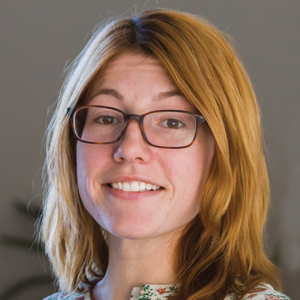Blockbuster bio
The shot opens on an American flag blowing in the wind. Suddenly the camera pulls back and rotates, and we realize the flag is attached to a Secret Service vehicle that is upside down and on fire. Smoke erupts from the United States Capitol in the background. A zombie emerges from the rubble and charges forward. We're not sure what we're watching, but we do know this is not your typical biology project.

Sarah Wetzel created her video exploring the potential for parasitic infections to cause zombielike symptoms as part of a course on teaching and learning biology at the University of Colorado, Boulder. Professor Michael Klymkowsky and colleagues introduced the video project to challenge students to solidify their own understanding of foundational concepts and to make these concepts accessible to people outside their field.
The course is required for all biology majors in the CU Teach program at UC Boulder. The program allows students to earn both a bachelor's degree and a teaching certificate in the STEM major of their choice. In addition to strengthening students' understanding of the concepts necessary to teach biology, the class is focused on techniques such as course design, course presentation and active versus passive learning.
Klymkowsky has taught an abridged version of the class at the Swiss Federal Institute of Technology in Zurich. Wherever he's teaching, his goal is to help students who are considering a teaching career to "realize that teaching and learning is more than just recognizing answers. It's being able to use and apply the information. What do you need to be able to use this information and make sense of it? How do you go from facts to scientific literacy?"
For the video project portion of the course, students are required to identify difficult concepts and explore what makes them challenging. They are free to choose anything related to biology that interests them. Past topics have included magnetic resonance, sauerkraut fermentation, proviruses, excessive sweating and the way reward pathways influence addiction.
Klymkowsky's former student Tim Vigers made a video about the chemical mechanisms that cause beer to go bad and take on a skunky flavor. "It was great that we were able to choose our own topic, because it meant that I was more motivated to make a worthwhile video," he says.
After choosing their topics, students must devise a hook — a way to pull viewers in in the first few frames and convince them that watching a five- to eight-minute video on a biology topic is well worth their time.
Next comes the storyboarding phase, where students lay out the sequence of shots they'll be using, and finally production of the video itself.
The students can use any technique they like to produce their videos, and Klymkowsky has seen narrated PowerPoint presentations, videogame-style animations and skits. Besides encouraging students to find a good microphone — "The first way you lose people is if they can't hear you," says Klymkowsky — he offers no technological guidance.
Students are encouraged to explore different options and decide which techniques best support their concepts. In the past, some have taught themselves stop-motion animation or used freeware available online to make cartoons. "It's a very creative process," says Klymkowsky. "You can really let go, which is not something you normally get to do in an average biology curriculum."

A significant amount of class time is dedicated to students presenting and discussing their progress at each phase and allowing them to bounce ideas around and get feedback from their audience. Klymkowsky says the biggest hurdle is thinking about why certain concepts are hard and what information is essential to understand them. Students must scrutinize their own knowledge and convey information in a way that makes it approachable and appealing to others. At first,"people tend to go in and just start rattling off facts, which are not useful or engaging," he says.
Vigers says the project helped him to grapple with the complexity of some of the concepts covered. "It was easy to feel like I had a good grasp of how systems work, but I usually found that I couldn't explain them to people," he says. "The video was a really great exercise in that and helped to pull the rest of class together."
There is no minimum requirement for time spent on these projects, although Klymkowsky estimates that they take an average of 20 to 40 hours. "They go off and do whatever they want, and they generally spend a very large amount of time," he says. "You can tell by looking at them — they're very cool."
Once the videos are completed, students share them with the public by posting them to YouTube. This way they each end the semester with product: something to show a future employer to demonstrate creativity and clarity of thought.
Klymkowsky sees other potential uses for the types of videos his students are producing. For example, after a paper is published, an accompanying video could help explain its significance, potentially broadening the paper's audience in the process. "The key is to make them engaging," Klymkowsky says, "to really think about who your audience is without just going through the figures of a paper."
Vigers, who is now a clinical research coordinator at Children's Hospital Colorado working on cystic fibrosis-related diabetes, says, "Dr. Klymkowsky's class made me realize that there are lots of things that you can do with a biology degree aside from bench research. I realized that I love educating people about biology, which is a big part of my job now."
Enjoy reading ASBMB Today?
Become a member to receive the print edition four times a year and the digital edition weekly.
Learn moreFeatured jobs
from the ASBMB career center
Get the latest from ASBMB Today
Enter your email address, and we’ll send you a weekly email with recent articles, interviews and more.
Latest in Careers
Careers highlights or most popular articles

Upcoming opportunities
Just added: Nominations are being accepted for FASEB's Excellence in Science Awards! Plus: Remember to register for the ASBMB Deuel conference, a must-attend event for lipids investigators.

Balancing research and classes in graduate school
Our careers columnist talks to a doctoral candidate about managing lab and study time by carefully scheduling classes, getting to the lab early and “timeboxing.”

Upcoming opportunities
Friendly reminder: Early-decision abstracts for the 2025 ASBMB Annual Meeting are due by Oct. 30!


The molecular biology of commercial cannabis testing
Anthony Torres of Front Range Biosciences, explains how scientists analyze organisms growing on the plant as well as the genetic markers in cannabis DNA.

Upcoming opportunities
Register for ASBMB's Oct. 19 virtual event on AI tools and alternative assessments in BMB education, featuring a keynote lecture by Emily Ruff!

